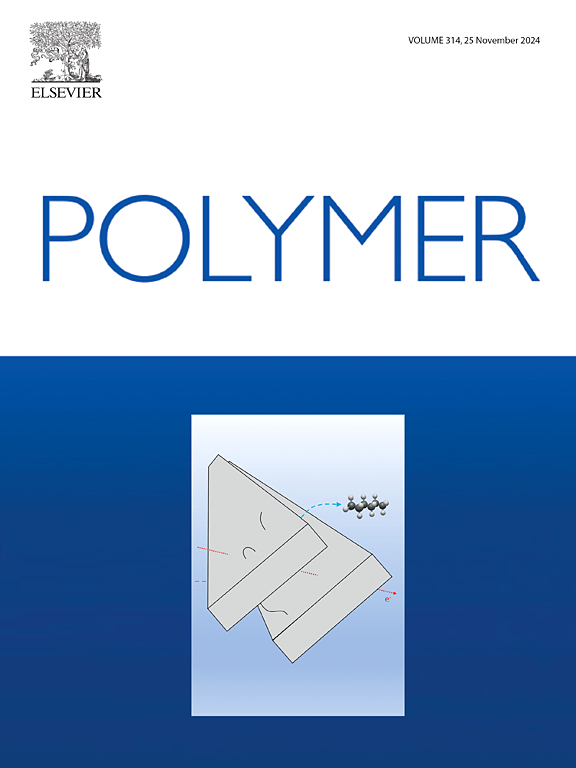生长动力学对聚丙交酯立体配合物超薄膜晶体形貌的影响
IF 4.1
2区 化学
Q2 POLYMER SCIENCE
引用次数: 0
摘要
利用原子力显微镜(AFM)和光学显微镜(OM)研究了不同结晶温度(Tc)和质量比下聚d -丙交酯/聚l -丙交酯(PDLA/PLLA)共混超薄膜中平面立体配合物片层的生长动力学和形貌。随着温度从170℃升高到195℃,PLA立体配合物(SC-PLA)片层的晶体形态由具有弯曲主分支和侧分支的枝晶转变为无弯曲的三角形晶体,同时早期生长速率(Ge)降低。同样,将PDLA与PLLA的质量比从1.5:1增加到9:1,导致Ge减小,而主分支的曲率半径(ρb)增大。通过测量生长薄片前耗尽带的宽度(wd),我们观察到一个有趣的现象,即ρb与wd通过幂律关系相关:ρb ~ wdα (α = 1-2,取决于分子量)。此外,在较高的Tc下,wd随时间增加,导致晶体的非线性生长(Ge随时间连续衰减),证实了扩散控制的生长机制。同时,当生长速率减小到约为Ge的40%时,立体复合片层晶体的厚度开始扩大。这表明非平衡生长动力学是SC-PLA树枝晶在超薄膜内的ρb和主分支厚度变化的主要因素。本文章由计算机程序翻译,如有差异,请以英文原文为准。


Influence of growth kinetics on crystal morphology of polylactide stereocomplex in ultrathin films
Atomic force microscopy (AFM) and optical microscopy (OM) were utilized to study the growth kinetics and morphology of the flat-on stereocomplex lamellae in poly(d-lactide)/poly(l-lactide) (PDLA/PLLA) blend ultrathin films at various crystallization temperatures (Tc) and mass ratios. As the Tc increases from 170 to 195 °C, the crystal morphology of PLA stereocomplex (SC-PLA) lamellae transitions from dendrites with curved main and side branches to triangular crystals without curvature, accompanied by a decrease in the early growth rate (Ge). Similarly, increasing the mass ratio of PDLA to PLLA from 1.5:1 to 9:1 results in a decrease in Ge, while the curvature radius of the main branch (ρb) increase. By measuring the width (wd) of the depletion zone ahead of the growing lamellae, we made an intriguing observation that ρb correlates with wd, through a power law relationship: ρb ∼ wdα (α = 1–2, depending on the molecular weight). Furthermore, wd increases over time at higher Tc, leading to a non-linear growth of crystals (Ge continuously decays with time), confirmed a diffusion-controlled growth mechanism. Concurrently, the thickness of stereocomplex lamellar crystals begins to expand as growth rate diminishes to approximately 40 % of Ge. This indicates that the non-equilibrium growth kinetics is the primary factor driving the changes in ρb and thickness of main branches of SC-PLA dendritic crystals within ultrathin films.
求助全文
通过发布文献求助,成功后即可免费获取论文全文。
去求助
来源期刊

Polymer
化学-高分子科学
CiteScore
7.90
自引率
8.70%
发文量
959
审稿时长
32 days
期刊介绍:
Polymer is an interdisciplinary journal dedicated to publishing innovative and significant advances in Polymer Physics, Chemistry and Technology. We welcome submissions on polymer hybrids, nanocomposites, characterisation and self-assembly. Polymer also publishes work on the technological application of polymers in energy and optoelectronics.
The main scope is covered but not limited to the following core areas:
Polymer Materials
Nanocomposites and hybrid nanomaterials
Polymer blends, films, fibres, networks and porous materials
Physical Characterization
Characterisation, modelling and simulation* of molecular and materials properties in bulk, solution, and thin films
Polymer Engineering
Advanced multiscale processing methods
Polymer Synthesis, Modification and Self-assembly
Including designer polymer architectures, mechanisms and kinetics, and supramolecular polymerization
Technological Applications
Polymers for energy generation and storage
Polymer membranes for separation technology
Polymers for opto- and microelectronics.
 求助内容:
求助内容: 应助结果提醒方式:
应助结果提醒方式:


